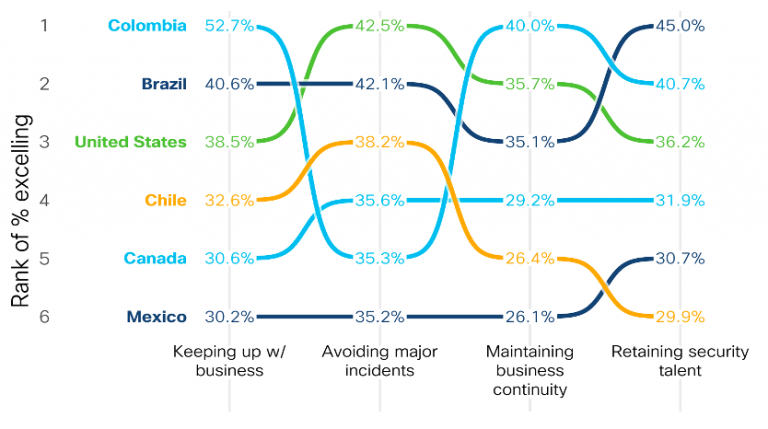
Why you might want to shake up your priority list
July 5, 2022
Securing the modern workplace
July 7, 2022Security Resilience in the Americas

The past couple of years have brought security resilience to the forefront. How can organizations around the world build resilience when uncertainty is the new normal? How can we be better prepared for whatever is next on the threat horizon? When threats are unpredictable, resilient security strategies are crucial to endure change when we least expect it.
In a previous blog post, we assessed security resilience in Europe, Middle East, and Africa (EMEA). Now, we take a look at organizations in the Americas to find out how they fare across four security outcomes that are critical for building resilience, based on findings from Cisco’s latest Security Outcomes Study. These outcomes include:
- Keeping up with the demands of the business
- Avoiding major security incidents
- Maintaining business continuity
- Retaining talented personnel
Country-level security performance
Based on the following chart, clear differences emerge when we examine these outcomes at the country level. The chart shows the proportion of organizations in each country that are reportedly “excelling” in the four outcomes contributing to security resilience.
What we see is that 52.7% of organizations in Colombia, for example, say their security programs are excelling at keeping up with the business, while only 35.3% report that they are excelling at avoiding major incidents. You can follow each country’s path through the four outcomes to see how they view their respective performance in certain areas.

What’s really at the crux of these differences in security resilience among countries? Is Colombia that much more resilient than Mexico? Do organizations in different countries have varying definitions of what resilience is, and how they perceive their success? Reasons behind these country-level differences can be attributed to a variety of things, including security maturity, cultural factors and other organizational parameters.
Find out how our customers in the Americas
are staying cyber resilient with Cisco
How to improve resilience
Knowing what we know about how organizations across the Americas view their resilience, how can they improve it? The Security Outcomes Study, Volume 2, sheds some light here. In the study, we uncovered five practices proven to boost overall success in security programs, dubbed as the Fab Five:
- A proactive tech refresh strategy
- Well-integrated tech
- Timely incident response
- Prompt disaster recovery
- Accurate threat detection
So, how did countries in the Americas rank their implementation of these Fab Five practices? If we look at Colombia, for example, 64% of organizations say their capabilities for accurate threat detection are strong, while only 48.1% of Canadian organizations say the same. There is a lot of movement around the top three countries: Colombia, Mexico and Brazil. The U.S. ranks fourth consistently across the board.

You may be wondering if implementing these five security practices improved resilience across organizations in the Americas. Our study found that organizations in the Americas that do not implement any of these five practices rank in the bottom 25% for resilience, whereas those that reported strength in all five practices rose to the top 25%.

Staying strong in the face of change
Resilience is a cornerstone of cybersecurity. The ability to quickly pivot while maintaining business continuity and robust defenses is increasingly important in today’s world. If you would like more insight on how to build a cyber resilient organization, please check out our resilience web page and the full Security Outcomes Study.
Watch video: What is security resilience?
We’d love to hear what you think. Ask a Question, Comment Below, and Stay Connected with Cisco Secure on social!
Cisco Secure Social Channels

